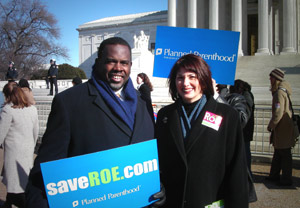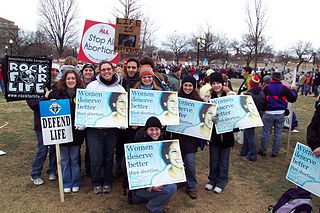Roe v. Wade, 410 U.S. 113 (1973), was a landmark decision of the U.S. Supreme Court in which the Court ruled that the Constitution of the United States generally protected a right to have an abortion. The decision struck down many abortion laws, and caused an ongoing abortion debate in the United States about whether, or to what extent, abortion should be legal, who should decide the legality of abortion, and what the role of moral and religious views in the political sphere should be. The decision also shaped debate concerning which methods the Supreme Court should use in constitutional adjudication.

The United States abortion-rights movement is a sociopolitical movement in the United States supporting the view that a woman should have the legal right to an elective abortion, meaning the right to terminate her pregnancy, and is part of a broader global abortion-rights movement. The movement consists of a variety of organizations, with no single centralized decision-making body.
Libertarians promote individual liberty and seek to minimize the role of the state. The abortion debate is mainly within right-libertarianism between cultural liberals and social conservatives as left-libertarians generally see it as a settled issue regarding individual rights, as they support legal access to abortion as part of what they consider to be a woman's right to control her body and its functions. Religious right and intellectual conservatives have attacked such libertarians for supporting abortion rights, especially after the demise of the Soviet Union led to a greater divide in the conservative movement between libertarians and social conservatives. Libertarian conservatives claim libertarian principles such as the non-aggression principle (NAP) apply to human beings from conception and that the universal right to life applies to fetuses in the womb. Thus, some of those individuals express opposition to legal abortion. According to a 2013 survey, 5.7/10 of American Libertarians oppose making it more difficult for a woman to get an abortion.

Abortion is a divisive issue in the United States. The issue of abortion is prevalent in American politics and culture wars, though a majority of Americans support continued access to abortion. There are widely different abortion laws depending on state.
The abortion debate is a longstanding, ongoing controversy that touches on the moral, legal, medical, and religious aspects of induced abortion. In English-speaking countries, the debate most visibly polarizes around adherents of the self-described "pro-choice" and "pro-life" movements. Pro-choice supporters uphold that individuals have the right to make their own decisions about their reproductive health, and that they should have the option to end a pregnancy if they choose to do so, taking into account various factors such as the stage of fetal development, the health of the mother, and the circumstances of the conception. Pro-life advocates, on the other hand, maintain that a fetus is a human being with inherent rights that cannot be overridden by the mother’s choice or circumstances, and that abortion is morally wrong in most or all cases. Both terms are considered loaded in mainstream media, where terms such as "abortion rights" or "anti-abortion" are generally preferred.
The National Right to Life Committee (NRLC) is the oldest and largest national anti-abortion organization in the United States with affiliates in all 50 states and more than 3,000 local chapters nationwide.
The paternal rights and abortion issue is an extension of both the abortion debate and the fathers' rights movement. Abortion can be a factor for disagreement and lawsuit between partners.

The United States anti-abortion movement opposes induced abortion, in-vitro fertilization, and some or all forms of birth control. Advocates support legal prohibition or restriction on both moral and religious grounds, arguing that human life begins at conception and that the human zygote, embryo or fetus is a person and therefore has a right to life. The anti-abortion movement includes a variety of organizations, with no single centralized decision-making body. There are diverse arguments and rationales for the anti-abortion stance. Some allow for some permissible abortions, including therapeutic abortions, in exceptional circumstances such as incest, rape, severe fetal defects, or when the woman's health is at risk.

Americans United for Life (AUL) is an American anti-abortion law firm and advocacy group based in Washington, D.C. Founded in 1971, the group opposes abortion, euthanasia, assisted suicide, embryonic stem cell research, and certain contraceptive methods. The organization has led campaigns and been involved in judicial actions to prevent the passage and implementation of legislation that permits abortion, or may increase prevalence of abortion, including successfully defending the Hyde Amendment in the U.S. Supreme Court.
The Republican Majority for Choice (RMC) was a Republican organization in the United States dedicated to preserving legal access to abortion. The group also supported federal funding for all kinds of stem cell research, including embryonic stem cell research.
In United States politics, the Freedom of Choice Act was a bill which sought to codify into law for women a "fundamental right to choose to bear a child; terminate a pregnancy prior to fetal viability; or terminate a pregnancy after viability when necessary to protect her life or her health". It sought to prohibit a federal, state, or local governmental entity from denying or interfering with a woman's right to exercise such choices; or discriminating against the exercise of those rights in the regulation or provision of benefits, facilities, services, or information. Provides that such prohibition shall apply retroactively. It also authorizes an individual aggrieved by a violation of this Act to obtain appropriate relief, including relief against a governmental entity, in a civil action".

Colorado Amendment 62 was an initiated constitutional amendment that appeared on the November 2, 2010 ballot defining personhood as “every human being from the beginning of the biological development of that human being.” It sought to ban abortion in the state of Colorado and challenge Roe v. Wade.

Anti-abortion movements, also self-styled as pro-life movements, are involved in the abortion debate advocating against the practice of abortion and its legality. Many anti-abortion movements began as countermovements in response to the legalization of elective abortions.
Abortion in Alabama is illegal. Historically, Alabama's abortion laws have evolved from strict regulations in the late 19th and early 20th centuries to a period of liberalization following the landmark 1973 Supreme Court decision in Roe v. Wade, which legalized abortion nationwide. However, Alabama has consistently enacted legislation aimed at restricting access to abortion.
Abortion in Illinois is legal. Laws about abortion dated to the early 1800s in Illinois; the first criminal penalties related to abortion were imposed in 1827, and abortion itself became illegal in 1867. As hospitals set up barriers in the 1950s, the number of therapeutic abortions declined. Following Roe v. Wade in 1973, Illinois passed a number of restrictions on abortion, many of which have subsequently been repealed. Illinois updated its existing abortion laws in June 2019. The state has seen a decline in the number of abortion clinics over the years, going from 58 in 1982 to 47 in 1992 to 24 in 2014.
Abortion in Colorado is legal at all stages of pregnancy. It is one of seven states without any term restrictions as to when a pregnancy can be terminated.
Abortion in the District of Columbia is legal at all stages of pregnancy. In 1971, in United States v. Vuitch, the U.S. Supreme Court upheld a law saying abortion was allowed for health reasons, which include "psychological and physical well-being". Consequently, the District of Columbia became a destination for women seeking abortions starting that year.
Abortion in Wisconsin has been legal since September 18, 2023, and is performed in Madison, Milwaukee and Sheboygan through 22 weeks gestation. However, elective abortions in Wisconsin are under dispute after the overturning of Roe v. Wade by the Supreme Court of the United States on June 24, 2022. Abortion opponents cite an 1849 law that they claim bans the procedure in all cases except when the life of the mother is in danger. However, lower level courts have argued that the law only applies to infanticide and not consensual abortions. The enforceability of the law is disputed and being considered by the state courts. Planned Parenthood of Wisconsin announced that they would resume abortion services in Madison and Milwaukee on September 18, 2023. Planned Parenthood of Wisconsin later announced that they would resume abortion services in Sheboygan on December 28, 2023.
Abortion in California is legal up to the point of fetal viability. An abortion ban was in place by 1900, and by 1950, it was a criminal offense for a woman to have an abortion. In 1962, the American Law Institute published their model penal code as it applied to abortions, with three circumstances where they believed a physician could justifiably perform an abortion, and California adopted a version of this code. In 2002, California passed a law guaranteeing women the right to have an abortion "prior to viability of the fetus, or when the abortion is necessary to protect the life or health of the woman." In 2022, California voters overwhelmingly approved Proposition 1, which amended the Constitution of California to explicitly protect the right to abortion and contraception by a margin of 33.76%.
The Association for the Study of Abortion (ASA) was an American organization founded around 1965 dedicated to the study of abortion and advocacy for the liberalization of abortion law. Its founding members included the obstetrician-gynecologists Alan F. Guttmacher and Robert E. Hall, who served as the organization's initial chairman.






